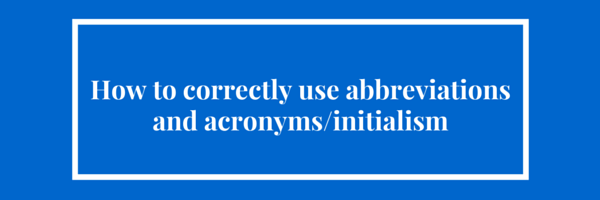First, let us define the terms Abbreviation, Acronym and Initialism. According to merriam-webster.com, abbreviation is ‘a shortened form of a written word or phrase used in place of the whole,’ while acronym is ‘a word (as NATO, radar, or laser) formed from the initial letter or letters of each of the successive parts or major parts of a compound term,’ and initialism is ‘an abbreviation (as FBI) formed from initial letters.’ Given these definitions, we can conclude that acronyms and initialisms are forms of abbreviation. And the difference between an acronym and an initialism is that we pronounce the letters in an acronym as a word, and we spell out the letters in an initialism.
Download the APA style guidelines in using abbreviations using the social buttons below
Now that we understand the definition of these words, the question is: Can we use abbreviations in academic writing? The answer is YES. But there are several things to remember when doing so:
Only abbreviate terms that appear four or more times in the paper.
If the research is about Post-traumatic stress disorder (PTSD), one would expect this term to be repeated multiple times in the paper. It would make more sense to use the initialism ‘PTSD’ instead of ‘Post-traumatic stress disorder’ over and over. There is no need to abbreviate terms that appear fewer than three times after its first use. When referring to a term or name of an organisation for the first time, always spell it out and then add the abbreviated name beside it. For example, ‘The American Psychological Association (APA) has set a writing style guide for academic documents. It is generally referred to as the APA style.’ Though there is no rule stating it is required to abbreviate a term used four or more times, it is advised that once an expression is abbreviated, the abbreviated form must be used consistently from then on. 
Use abbreviations to make reading easier.
Anglo-Australian Near-Earth Asteroid Survey is a mouthful, isn’t it? Reading it several times can be cumbersome, so using the initialism AANEAS would help. Same rule applies to units of measurements. Though saving time and effort is important, we should not confuse readers with unrecognisable words. Better stick to common abbreviations, or ones the intended readers are familiar with. This means if the reader has to stop and Google the meaning of the abbreviation used, then it is best not to use it. If use of an uncommon abbreviation cannot be avoided, define the expression so the readers will understand.
Avoid abbreviations that can be misunderstood.
Acronyms and initialisms may have several meanings. WWF used to mean something to wrestling fans. Now, one is more likely to think ‘panda’ when reading WWF. Though NSFW means National Schools Film Week to some people in the United Kingdom, it is more commonly known as a warning for content best not viewed in a public setting, like the office. As previously mentioned, we should not confuse readers with unrecognisable words. Neither should we confuse them with expressions they may misinterpret.
Save text speak for text messages.
Never 4get that ur adviser will not LOL over ur paper full of IM abbr. Abbreviations we use in social media or text messaging is inappropriate for academic writing. Our aim is to make readers easily understand what we write, and proper use of abbreviations can help us achieve that. But incorrect use, or overuse, of abbreviations may confuse rather than help. So when in doubt, spell it out!
Download the APA style guidelines in using abbreviations using the social buttons below

